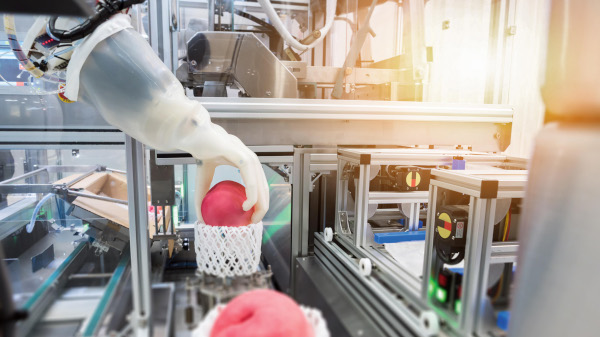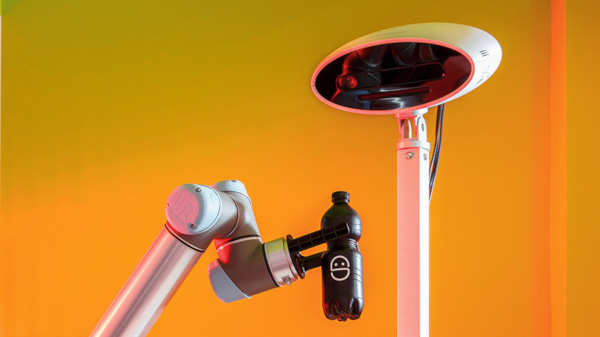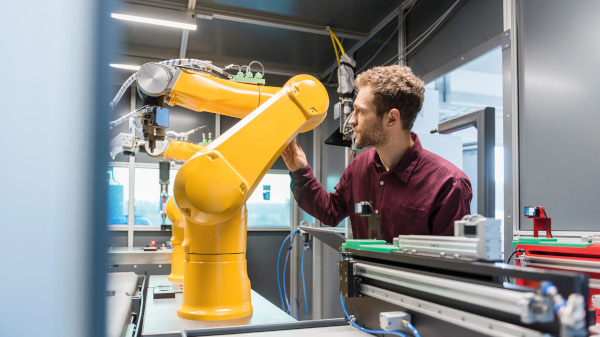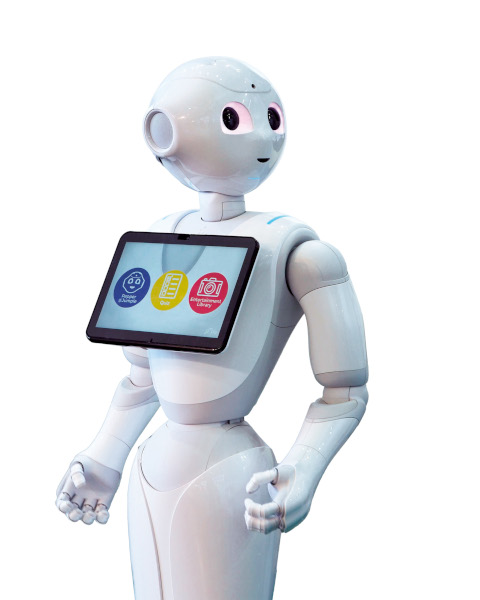Some cobots (especially industrial devices) are programmed to handle specific tasks yet they incorporate “learning” capabilities for self-improvement as they work with humans. Other cobots are built around their AI capabilities to learn how to socialize with humans and develop the support or assistance features needed in life situations. Through tools such as 3D vision, a cobot can detect a human activity such as a hand movement and algorithms control cobots to coordinate a cooperative procedure, for example on a production line, in surgery or helping out with a household chore.
“Some collaborative robots can be trained by hand, unlike traditional industrial robots which usually require programming via a teach pendant or other device,” explains Jeff Burnstein, president of the Robotic Industries Association (RIA), part of the Association for Advancing Automation. “We’re seeing consumer robots that can be voice controlled, such as robotic vacuum cleaners,” he adds, pointing out the creative interfaces that are taking shape as cobots learn to collaborate with humans in new business and personal situations.
Lesley Rohrbaugh, CTA’s director of research says, “Consumer robotics are bringing game-changing innovations to sectors including health care, education, retail and delivery.” She adds, “Consumer robotics are constantly becoming smarter and more capable,” noting that, “Social robots that can perform a variety of functions represent a new breed of consumer robotics.” Rohrbaugh also cites hotel concierge robots and health-focused robots helping in-home senior care and hospitals as part of the social cobot process.
CTA’s latest study about consumers’ attitudes toward robots found that 81% of respondents are “open to using robots for leisure and recreation” with an even higher acceptance among 35-to-54-year olds. The CTA research found about a quarter of those polled mentioned “fun” and “entertainment.” Nearly half of respondents say they expect that home robots will make life easier and more convenient.
Consumer robotics are bringing game-changing innovations to sectors including health care, education, retail and delivery.Lesley Rohrbaugh, director of research, CTA
Professor Manuela Veloso, who is on leave from Carnegie Mellon University to head AI research at J.P. Morgan (the financial collosus), has pioneered work in “symbiotic autonomy” to create cobots that ask humans to help them, such as humanoid assistants that accompany campus visitors to appointments. She notes that indoor robots often have limitations, such as the inability to access Global Positioning System (GPS) satellites for navigation.
Veloso, who headed the Machine Learning Department at CMU’s School of Computer Sciences, focuses on services the cobots can learn from human companions, such as cognitive and perceptual skills. This process has been incorporated into several social robots, she explains, pointing out that companion cobots should be optimized to learn from humans on how to process unexpected encounters.
“Social robots should be able to handle situations 'outside the rules' of what they are programmed to do,” Veloso explains. This makes them more flexible “to identify and be alert” for new social situations and conditions. She also envisions social robots who are attentive to specific conditions when used as health care companions, which will require lots of cognitive and physical help. “The cobots will know when a human needs actual physical assistance,” Veloso predicts.

Matt Beane, assistant professor of technology management at the University of California, Santa Barbara, sees a future in which “experts, apprentices and intelligent machines work, and learn, together.” In a Harvard Business Review article, “Learning to Work with Intelligent Machines,” Beane examined cobot opportunities ranging from surgical operating rooms to police forces, investment banks and online education. Beane, who is also a research affiliate with MIT’s Initiative on the Digital Economy, concluded that in the human/robot relationship, machines with AI features will learn how to do things in the same way new employees, interns and trainees have done for millennia: through an informal process he calls “shadow learning.” Beane says, “On the hardware side, augmented reality systems are beginning to bring expert instruction and annotation into the flow of work,” citing “smart glasses to overlay instructions on work in real time.”
In particular, cobots as well as the humans who work with them, should have opportunities to collaborate and understand the skills and capabilities of each other for each task. Beane advises that it will be necessary to restructure roles and incentives to help learners master new ways of working with intelligent machines. Organizations also will have to build searchable, annotated, crowdsourced “skill repositories” containing tools and expert guidance that learners can tap and contribute to as needed.
“We’re now seeing technology that allows traditional industrial robots to work side-by-side with people without fences between them,” says Jeff Burnstein of the Robotic Industries Association. He cites, assistive devices like exoskeletons as an emerging sector of the cobot world that work with a human on tasks such as lifting heavy objects or in the consumer health applications that help people stand and walk.
Burnstein points to warehouses where, “We’re already seeing people monitor a fleet of robots rather than walking miles each day tugging heavy loads. This allows us to get our products faster, enabling companies to hire more people to meet the demand of e-commerce, even as companies adopt more robots.”

Cobots are being deployed in fields such as aeronautics, pharmaceuticals, food and beverage processing, machine and automotive manufacturing and agriculture. They are used to enhance the traditional role of robots which has been assigned to the “four D's” of industrial tasks: Dangerous, Dirty, Dull (or Demeaning) and Dear (i.e. expensive), as a recent Forbes article explained. Cobots provide super strength, precision and data processing and can learn from their collaborators new ways to handle processes. For example, in automaking or vehicle repair, cobots can learn from human touch how to control the force of hand-sanding the paintwork of a car unlike the pre-programmed pressure of a robot sander.
Smart Robots, an Italian firm that makes industrial robots, stresses the values of robot/human cooperation as smart co-workers. ”The human operator accomplishes crucial high value-added activities” when working with cobots, which means the person can learn the process about 50% faster, the company explains, while the collaborating robot “performs repetitive and less ergonomic tasks” that might distract the human. Smart Robots, launched in 2016, has found that the cobot process generates a 40% to 100% productivity improvement, 90% reduction of human errors (a steep cost reduction by eliminating waste and re-work) and creates higher quality “thanks to robots’ repeatability” and lower operator risks in “ergonomically harmful tasks.”

FANUC America, a 50-year-old industrial robot manufacturer, demonstrated its new cobot capabilities at CES 2020, focusing on its 3D vision camera and voice activated features that engage the human/machine manufacturing relationship. FANUC’s built-in sensors allow cobots to work alongside humans without expensive guarding barriers that can affect procedures. Intelligence in the cobots can detect colors and shapes at very high speeds, helping in production, distribution and packaging tasks such as picking and sorting pills or odd-form electronic components.
Experts see the flexibility of cobots for learning how to handle delicate items (such as packaging) and detecting and identifying new products quickly (via vision sensors). The features will be useful in retail stores where a human clerk could use a cobot for inventory retrieval and presentations.
“Intuitive communications with humans” is a core factor in entertainment and leisure cobots as well as the companionship and assistive cobots that consumers will bring home in the next five years, according to analysis by Insight Partners. A separate study by Research N Reports puts the social cobot growth curve at 14% annually through 2026. Although the predicts are relatively modest, the overall outlook points upwards. It reflects global activity as companies look for opportunities for social, entertainment and companion devices.
One obvious factor are the various approaches being created. The Carnegie Mellon University “symbiotic human-robot” project has focused on human modeling, including intelligence that enables the cobot to know, for example, when a human may be thirsty or when they want to hear information about a specific task.
CTA’s 2019 study on consumer perceptions of robotics found that over half of respondents envision devices to help with household chores such as cleaning, laundry and painting. “Most consumers see robots as autonomous computers, but 38% believe that robots must be able to tangibly impact the world around them,” CTA found, suggesting that physical interaction may not be an essential factor in human collaboration. Yet the popularity of “leisure and recreational” devices (91% awareness level; 66% positive perceptions in the CTA study) suggests a sizeable potential market for collaborative technology that may include drones and other devices that provide entertainment and productivity functions.

Some sectors of the social cobot market may be slow to develop, as consumers ponder their value. Robots that interact with people are finding fans for therapeutic use by those with autism and other conditions, companions for seniors as well as customer service in retail stores, hotels and hospitals.
Pepper, SoftBank’s human-shaped robot, developed as a companion that can perceive and act upon human emotions, tells jokes, dances and responds to human moods. In the five years since its debut, it has found applications in retail and restaurant venues and as an educational device to teach students how to code by creating applications for its Pepper humanoid
Omron Automation showed its Forpheus emotion-reading robot at CES 2020. The cobot can interpret body language and then generate messages of advice and encouragement. Omron says Fopheus can also play ping pong and predict an opponent’s next shot by tracking movements, a skill that Omron can adapt to companion care.
Pillo Health launched its Pillo “Pria!” pharmaceutical dispensing companion cobot working with Black & Decker. The device “wakes up” when it’s time for a dose of medication, alerting a patient to take the pill(s) that are being dispensed. Through digital connections, professional and family caregivers can monitor the patient’s health remotely for compliance.
AV1 is a telepresence robot, developed by No Isolation, a Norwegian startup focused on reducing children’s isolation. The small robot acts as a child’s eyes, ears and voice in the classroom. For a student with a long term-illness who cannot attend school, AV1 in the classroom can raise its hand and convey the remote child's questions.
Although some companion and toy cobots have come and gone (Jibo, Lynx), new products continue to enter the market.
The outlook for both industrial and social cobots is enormous. The market for cobot arms alone is expected to muscle up from about $2 billion now to $11 billion by the end of this decade, according to ABI Research. Other analysts at The Technology Partnership envision complex developments of “human-multi-robot collaborative teams” in which specialty cobots are used to tackle specific segments for complicated tasks: different robots would work with each other, performing various functions to do better jobs collaboratively.
Veloso of Carnegie Mellon and J.P. Morgan envisions a next generation of cobots that will figure out for themselves when they need assistance and request help from human partners. Some analysts expect that as cobots develop social skills, they will become more popular as companions and more widely used than industrial robots.
RIA’s Burnstein expects that “technologies such as machine vision and AI will speed adoption” of cobots, although he expects the industrial sector will grow more quickly. “The future involves people and robots working together, not robots replacing people,” says Burnstein. “We’ll see robots doing more tasks people don’t really want to do, allowing people to do higher value work that is safer, higher paying and more satisfying.”
“We are early in the global adoption of robotics,” he adds, predicting that “we’ll see useful consumer robots doing more than just vacuuming or cutting our lawns in the near future.

I3, the flagship magazine from the Consumer Technology Association (CTA)®, focuses on innovation in technology, policy and business as well as the entrepreneurs, industry leaders and startups that grow the consumer technology industry. Subscriptions to i3 are available free to qualified participants in the consumer electronics industry.